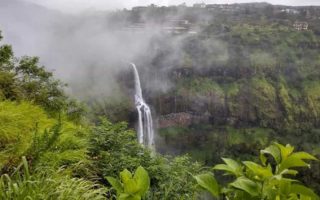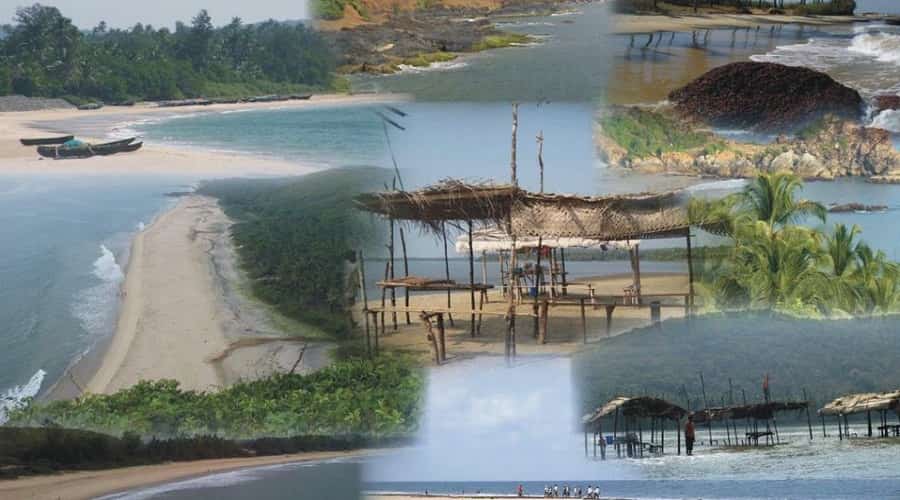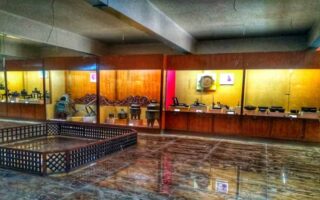For those who are adventurous and love to explore through the sands of time and go through the various histories tossed and turned by the waves of time, Maharashtra is a haven. Filled with splendorous and rich forts situated mostly throughout the state, placed close towards the tranquil shores of the various Beaches, the Maharashtra fort provide the most enthralling experience that any history lover cannot resist.
For anyone who wants to embark on an incredible Adventure through time, in Maharashtra, there is no better place to start with other than the Maharashtra forts. Every Maharashtra fort is embodied not only with its magnificence and eloquence but also with its historic tales that has its roots buried deep into the evolution of India. The forts of Maharashtra stand tall with the significance of time embodied with prestige, valour and heritage of the state. The Maharashtra forts are filled with tales of outstanding courage, inspiring tales of chivalry, that are capable of inspiring anyone and everyone who are bound to hear about it, extraordinary feats of battle and struggles of some of the strongest of empires that ruled India and so on.
The architecture of the Maharashtra forts comprise of many significant traditions and art work, which makes these forts not only a significance and a monument of power, but also a monument right with long-lasting traditions. The forts also depict the changes of power also with the various strengths of the monarchs of that time. The forts also have within them various artefacts and ancient equipments used during the distressed times of wars, for the sake of protection and conquer.
The forts also depict in them a History of the various battles fought from the particular fort and also about the entire history revolving around the various fort’s of Maharashtra. The very size of the forts and the enriched magnificence of the fort is enough to take away any one’s imagination into the very times of its use and its grandeur. The beautiful interiors of the forts are in many places, decorated with ancient art that are enriching to the soul of anyone who sets their eyes on them. This is the main reason why locals as well as travellers from around the world flood though the gates of the Maharashtra forts.
Sindhudurg Fort
- Location: 49 km from Pune
- Altitude: 1312 m
- Built in: 2000 years ago
- Highlights: Trekking trails
- Timing: 8:00 AM – 6:00 PM
- Time required: 1-2 hours
- Entry fee: Free
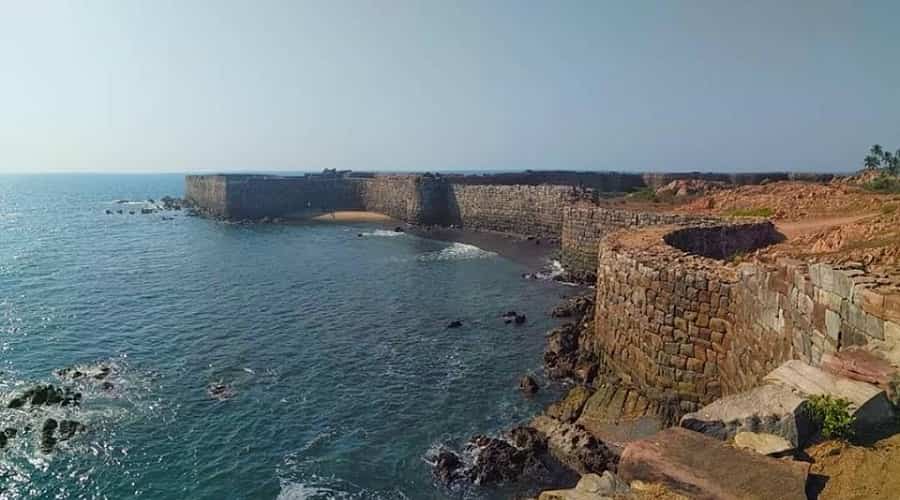
Sinhagad Fort happens to be one of the most famous forts of the people, not only because of its splendour and elegance, but also due to its characteristic of being one of the most famous Trekking spots for tourists. The Sinhagad Fort adds mainly and greatly to the view and splendour of the city of Pune. The fort lies very much in the vicinity of the city making it easily accessible and favourable for all. It is perched at an altitude of about 700 m approximately. The altitude happens to be the main reason why the trekking is very famous in this area. Among the various beautiful and challenging trekking locations situated, one of the most famous and stunning locations happens to be the route accessed through Katraj, which is attached with Sinhagad.
Since the Sinhagad Fort is merely 25 km from the city of Pune, it happens to be one of the most favoured picnic spots by people. The sands of time and the flow of the era, has slowly eroded the entire splendour of the Sinhagad Fort, but even at this stage the magnanimity of the fort is seen in its ruins. The fort has witnessed countless number of battles, and has been consumed by the passing travails of the world. One of the most significant battles including the battle in which, Tanaji Malusare, a loyal general of the army of Shivaji, recaptured this fort and lost his life like a lion. The fort was renamed as Sinhagad – the lion fort – after this courageous army man.
The beautiful fort, though in ruins, speaks of old times through its history and architectural importance. The other important buildings present within the fort are the samadhis of the leader Tanaji Malusare and the youngest son of Shivaji, Rajaram, who was also buried here. The other significant structures present inside the premises of the fort are the bungalows of Lokmanya Tilak, a very famous and significant freedom fighter, and G.D. Madgulkar, one of the famous Marathi poets. The Sinhagad Fort now serves a different purpose for training the members of the National Defence Academy. It is an absolute must that tourists who visit the Pune city of Maharashtra, India, must make it a point to visit this amazing fort full of splendour, at least once.
Raigad Fort
- Location: Raigad District of Maharashtra
- Distance: Approximately 125 km from the city of Pune.
- Built by: Chhatrapati Shivaji
- Built in: 17th century
- Timing: 10 AM – 6 PM
- Time required: 3-4 hours
- Entry fee: INR 10
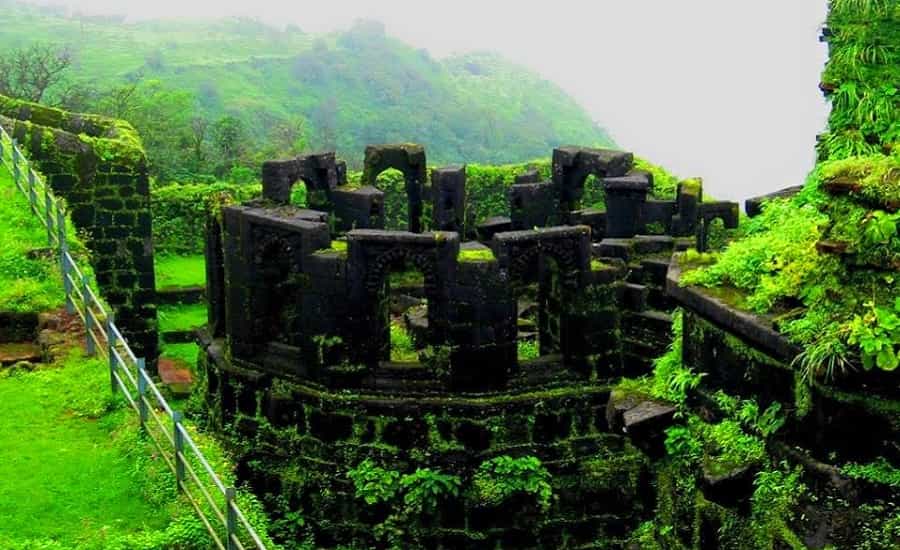
Raigad Fort is one of the magnificent forts of India, and is considered as one of the most beautiful hill fortresses situated in India. It is placed in the Raigad district of beautiful Maharashtra. Situated at a distance of about 125 km apart from the city of Pune, it happens to be one of the most favoured excursion spots for the city people as well as the tourists, who love its absolute grandeur.
The Raigad Fort served as the capital of the great Maratha King Chatrapatti Shivaji, around 1674, when the prince was termed as king. The magnificent fortress, as its splendour ruler, was built at an exceeding altitude of 1350 m that is about 4530 feet above the level of the sea. The proud Raigad Fort falls under the mountains ranges of the Sahyadri Mountain Ranges.
The fortress was initially known as Rairi fort, built by the Chandarrao Mores – an offshoot dynasty of the Mauryans’ imperial Dynasty. After the capture of this fort the great king Shivaji renamed it as the Raigad Fort which also translates into the king’s fort. In order to reach this great fort one has to climb an approximate of 1400-1500 steps. It is believed that the Maratha king renovated the entire fort before moving in. In case people do not want to climb those many stairs, one can get to the top by a rope system, solely built for the convenience of the visitors.
Some of the main structures within the Raigad Fort comprises of the elegant Queens’ Quarters, consisting of six magnificent chambers, mainly for the use of the queen and her female attendants. Other structures include the public durbar, the watch towers and the Darwazas. Most of the fort was made out of wood and now it lies in ruins, but yet the splendour of the fort still remains, the base made out of solid rock stands for all to see, a special gate known as the Mena Darwaja provided entrance to the court ladies, leading to the queen’s quarters. The Nagarkhana Darwaja faces the Rulers throne.
From the grounds of the palace one can see the Takmak Tok – a steep cliff that served as the point of execution for the prisoners, who were thrown into its steep ravines. The house of the king still houses a similar replica of the throne. The magnificent Maha Darwaja serves as the primary entrance to the Raigad Fort, offering ample protection from potential invaders. But the King’s convoy was supposed to move through the Palkhi Darwaja. Other specifications include the three dark chambers which were supposed to be the granaries of the court. Another main attraction of the fort premises happens to be the huge statue of Chhatrapati Shivaji, placed adjacent to the market place of the market avenue. The tomb of the great King along with his favourite and faithful dog is situated near this very avenue.
Shivneri Fort
- Location: 90 km from Pune.
- Founded by: Shahaji, Maharaj Shivaji’s father
- Built in: 17th-century
- Highlights: Birthplace of Shivaji
- Timing: 24 hrs
- Time required: 2-3 hrs
- Entry fee: Free
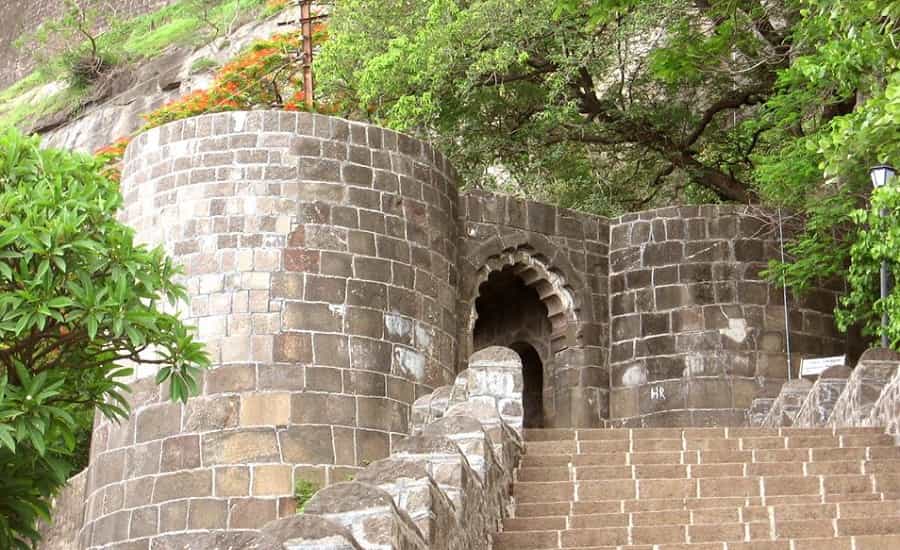
Shivneri Fort is supposed to be one of the most magnificent forts of Maharashtra; thanks to its natural beauty, architectural supremacy, historically rich heritage, and the culturally inculcated forts of India. The ancient fort has a lot of significant historical background due to its relationship with old monarchs. The Shivneri Fort is dated back to the era that existed since before the birth of the Chhatrapati Shivaji Maharaj. This fort was built under the guidance of Monarch Shahaji, who was the father of Shivaji, and the main reason behind the construction of this fort was to provide an enclosure, for valid safety and protection against the attack of enemies, against his land and family. As a matter of fact, Jijabai, the mother of Shivaji spent most of her days during pregnancy, only in the various chambers of this magnificent fort. Also, this very historical place was indeed the birth place of Chhatrapati Shivaji Maharaj, in the year 1627.
The entire part of the Great King Shivaji’s childhood was believed to have been spent within the protective walls of this fort. The Great King received most of his various types of education here, and it is a fact that this very education helped in shaping the nature and character of the child Shiva into a magnificent ruler Chhatrapati Shivaji Maharaj, who conquered many parts of the land of Maharashtra. Among the other notable facts, apart from the connection with the Great Ruler Shivaji, is that the fort also boasts the presence of some of the most beautiful, Cultural and architectural Statues of Maharashtra. The king Shahaji, in order to make the entire architecture enemy-proof, constructed seven gates, through which anyone who wishes to enter the great Shivneri Fort has to pass, before coming close to the proximity of the forts entrance.
Badami Talav is a small pond constructed at the heart of the magnificent fort, it is considered as one of the most capturing features. In close proximity and more or less adjacent to the tranquil pond, is a statue depicting Jijabai along with the Great King Shivaji as a child. Apart from this, there are a large number of statues, with specific architecture that is refreshment for the eyes. Within the Shivneri Fort is also a Temple, that is dedicated to the Goddess Shivani. People believed that this is where the Great Monarch derived his name from. Apart from this magnificent fort, there are other structures worth noting, such as the beautiful Naneghat, Jivdhan fort, etc. Anyone who visits the city of Pune must make it a point to visit these magnificent places of historical significance.
Purandar Fort
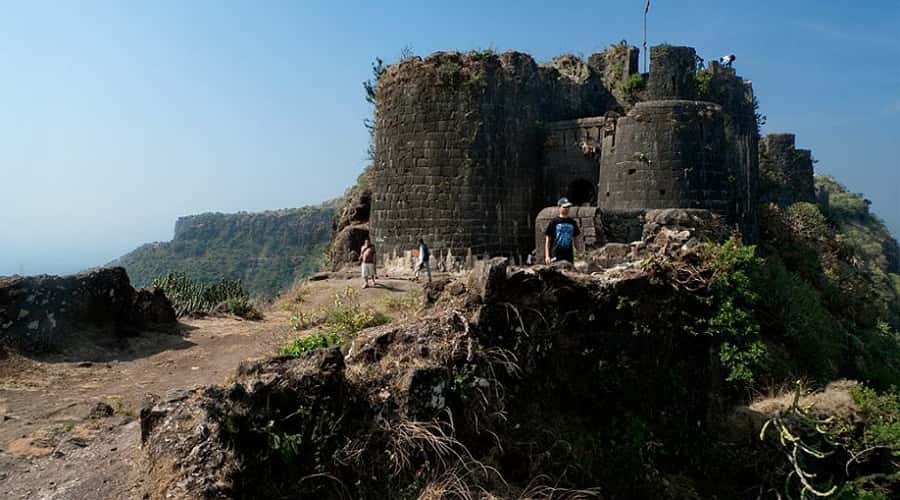
Nestled high above at the altitudes of 1398 meters amid the unyielding rocks, Purandar Fort is exactly located in Narayanpur village of Pune district of Maharashtra. Tracing back the time period of 1350, Purandar has served many regimes of many dynasties but again it was only Shivaji Maharaja who made this fort to be written in history. He fortified the fort further and made it a threshold of Maratha Empire. Shivaji Maharaja started his regime from Raigad Fort but after some years, he shifted in Purandar Fort and made it even the royal capital.
The fort served the Marathas for a prolonged period before falling into the hands of British. Purandar Fort is particularly famous for its impregnable architecture. The other reason that makes Purandar Fort so popular is that it is the birthplace of Sambhaji Maharaj, the eldest son and successor of Shivaji Maharaja.
Pratapgarh Fort
- Location: 24 km from Mahabaleshwar
- Built by: Chhatrapati Shivaji Maharaj
- Built in: 1656
- Timing: 9 am to 6 pm
- Time required: 4 to 6 hours
- Entry fee: No entry fee
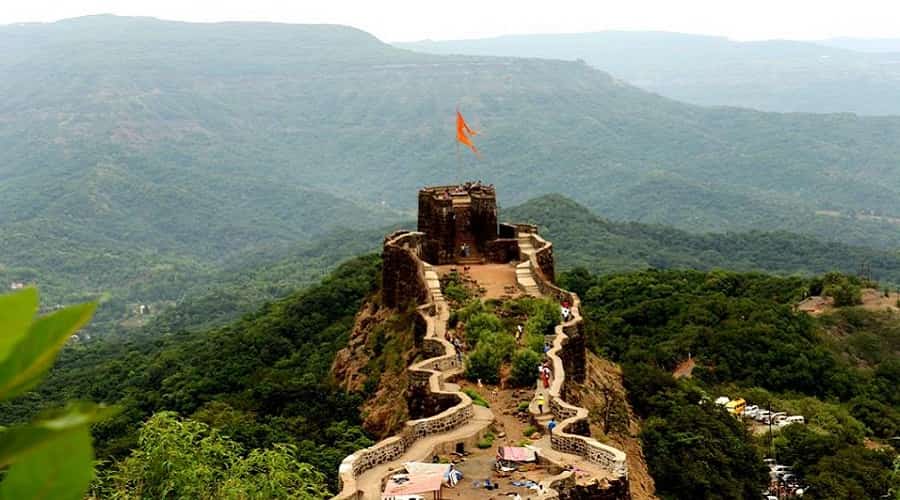
If you would know even a bit about Shivaji Maharaja, you must be aware of the fact that he was profoundly passionate about the forts. During his regime, he commissioned and conquered numerous sublime forts. In fact, the most of forts of Marathas were either built or captured by him only and Pratapgarh Fort is one of them. The site has witnessed the fierce battle between Shivaji Maharaja and Afzal Khan.
Apart from such a significant event of Maratha history, the fort is also famous for its awe-inspiring location and stately architecture. Located in the panoramic hill station of Mahabaleshwar, Pratapgarh Fort is a mountainous fort built by Shivaji Maharaja. Perched 1080 meters above sea level, it renders a fascinating view from high above. Pratapgarh fort is among top forts to visit in Maharashtra.
Daulatabad Fort
- Location: about 13 km from Aurangabad
- Built by: Yadava dynasty (Bhillama V)
- Built in: 12th century AD
- Timing: 9:00 am to 6:00 pm
- Time required: Around 3 hours
- Entry fee: ₹ 10 for Indians; ₹ 100 for foreign tourists
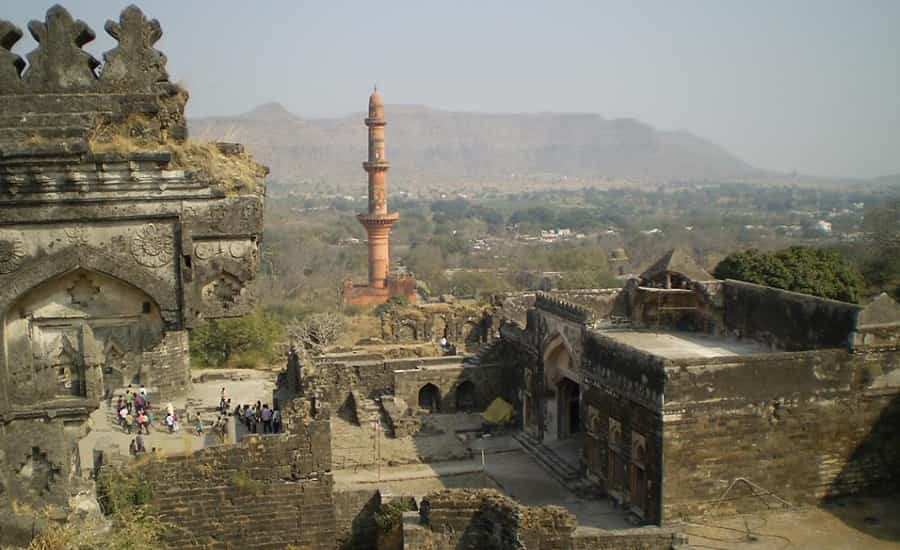
Daulatabad Fort is one of the rarest forts of Maharashtra that has nothing to do with Marathas. In fact, it is known for this reason that Shivaji Maharaja could never get hold of this fort. Tagged as the ‘Seven Wonders of Maharashtra’, Daulatabad Fort is probably the most splendid fort of Maharashtra from the architectural aspect. It was built during 12th century by a Hindu ruler and at that time, it was called Devagiri. But later, it was captured by Muhammad Bin Tughlaq and renamed as Daulatabad Fort.
Like other Muslim monuments, Daulatabad Fort also portrays a Muslim architecture adorned with exceptional designs. Lying just 13 km from Aurangabad city, Daulatabad Fort is an ideal destination for the history and adventurous enthusiasts.
Panhala Fort
- Location: About 19 km from Kolhapur.
- Altitude: 850 m
- Built by: Raja Bhoja
- Built in: 1178 and 1209 CE
- Timing: 06:00 am to 07:00 pm
- Time required: Around 3 hrs
- Entry fee: No entry fee
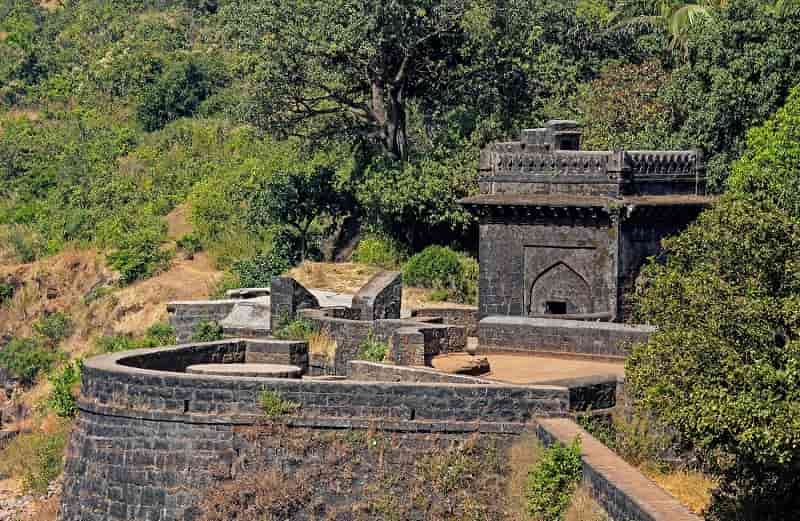
Panhala Fort is situated approximately at about 19 km from the beautiful city of Kolhapur in Maharashtra. In the Deccan region, this fort is regarded as one of the grandest and most expansive fortifications. This fort is also well known for its significance. The fort is situated at an altitude of about 850 m above the sea level. The size of the fort is absolutely enormous and the sheer surroundings are massive. The circumference of its area of cover alone is about 7.25 km. this type of structure provides the perfect source of protection for the Panhala Fort. Almost half of the length of the fort comprises of natural scarp that has been duly reinforced and strengthened with the help of a parapet wall that covers its area. The other half of this enormous fort has been covered with the help of a massive stone wall, comprising of hard and impenetrable stone.
The inside wall of this great fort has also been reinforced and strengthen to a great extent with the aid of fortresses. The Panhala Fort initially comprised of three gates that were huge and double walled. But over the sands of time only two gates remain today. The inner surroundings of the fort comprises of some magnificent buildings which though ruined, still comprise of their magnificent splendour. The other attractions placed within the fort include the Teen Darwaza, which still remains as an impressive structure. The other buildings include the three massive granaries, which are placed within the boundaries of the fort of which, Ganga Kothi is the largest, based on an expanse of about 950 sq m, and comprises of a height of 10.7 m.
Many other impressive buildings are also placed within the fort, which includes the Sajja Kothi in which the great king Sivaji placed his way ward son, Sambhaji. The inner campus also comprises of the Ramachandra Amatya Samadhi, who was the author of Ajnapatra, which was an important work of statecraft. The Panhala Fort was also the capital of Shilahara King Bhoja II. After the king, it fell into the hands of the Yadava and Bahmani kings. By the year 1489 the Adil Shahi dynasty took over the great fort.
The fort was then taken over by the great ruler Chhatrapati Shivaji, who defeated the Shahis. In fact, it was for this very Panhala fort that Shivaji escaped to Vishalgad when he was attacked by Siddi Johar. The forts heritage continued as it shifted from the Maratha rule to the Moghuls, the fort remained under the state of Kolhapur till India received her independence. Anyone who visits the state of Maharashtra must make it a point to visit this magnificent Panhala Fort.
Ahmednagar Fort
- Location: Situated in Ahmednagar district, Maharashtra, India
- Distance: approximately 140 km from the city of Nasik
- Built by: Husain Nizam Shah
- Built in: 1559 AD
- Timing: 9.30 AM to 6 PM
- Time required: Around 2 hours
- Entry fee: Free
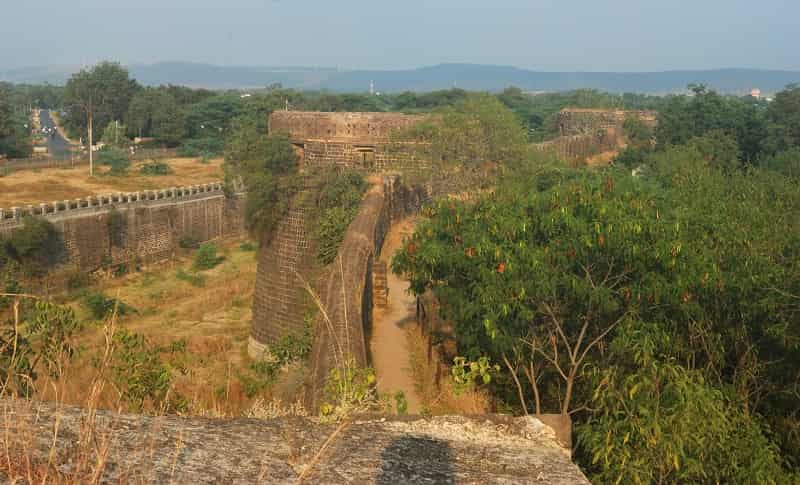
Ahmednagar Fort is considered to be one of the best designed and architected forts of Maharashtra. It is a massive structure and its splendour is studied in various forms of Indian history. As a matter of fact no Indian history is complete without the mentioning of the Ahmednagar Fort.
The speculations about this impregnable fort are seen to be true, to anyone who brushes through the History of this mighty and magnificent fort. The Ahmednagar Fort also happens to be one of the oldest forts to be built, for it was constructed long ago as 1559 AD, under the guidance, patronage and wishes of Husain Nizam Shah.
The Ahmednagar Fort is seen to be surrounded by a vast area of cantonment on all four sides of the huge fort walls. It is found to be on the eastern side of the city of Ahmednagar. The fort is oval in shape and has a circumference of about 1.70 km. The Ahmednagar Fort was well known for its defence systems, which comprised of 24 citadels surrounding it, along with a gigantic moat which is 30 meters wide in total and about 4 to 6 meters in its depth. The stone wall of the Ahmednagar Fort is known for its strength, at a total of 25 meters in height, the stone wall alone was enough to frighten its foe.
The fort can be entered via two entrances, which can be reached only after the person trying to reach it enters the fort through the moat, with the help of the suspension draw bridges that stand strong for the last 4 centuries. In spite of its age the fort still stands intact, with many of its artefacts and structures in full splendour.
The history of the Ahmednagar Fort is long and interesting; it has been the victim of numerous attacks and invasions over the years. The first to attack its massiveness was the Mughal army in 1596 that were laden with sour defeat, and had to order a retreat. The fort was later annexed by the Mughals in 1600, due to the valour of its forces led by Akbar. But later the control of the fort was lost in 1759, when they had to sell it to Sadashiv Bhau, the third Peshwa’s cousin. Later Daulatrao Shinde lost the control of the great fort to General Wellesley in the year 1803. Ultimately, one day later, the Treaty of Pune was signed and the control of the Ahmednagar Fort was handed over to Bajirav Peshwa II.
The history about the fort also tells us that this fort was also used as a royal prison more than once, due to its magnificence in security and structure. This includes the time where the entire Congress Working Committee members were detained at this fort during the onset of the Quit India Movement in 1942. The Ahmednagar Fort, thus, stands tall after all its endeavours, and is therefore stated as one of the must to visit locations for any one visiting Nashik.
Janjira Fort
- Location: Murud, Maharashtra
- Founded by: Chhatrapati Sambhaji Maharaj
- Founded in: 15th century
- Timing: 06:00 AM to 06:00 PM
- Time required: 1-2 hours
- Entry fee: Free
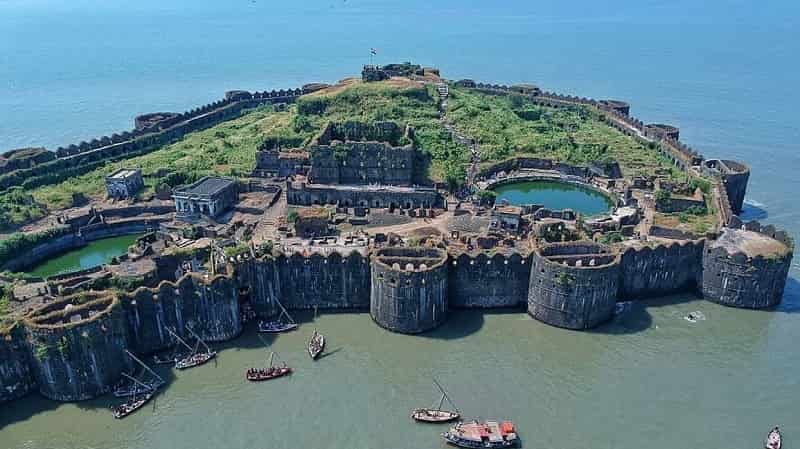
Janjira Fort is mainly situated on the coastal beach side of the Murud town of the state of Maharashtra; it is situated on the beautiful sea shores of the Arabian Sea. It is an island fort and it serves mainly as the most important and significant fort of Maharashtra. The city of Murud was the eastward state capital of the Janjira rulers during the early times.
In today’s times this fort is considered as one of the rare seaside forts of India and is greatly treasured for its grandeur and beauty. The Janjira Fort is located almost 2 km within the city of Murud. The massive fort has retained her splendour and grandeur in spite of living through numerous attacks during her prime time, and its beauty is still magnificence for the eye to see, in spite of being lashed and slashed by the massive waves of the Arabian Sea.
The assault on the Janjira Fort was commenced by great rulers including, the Great Shivaji, to the magnificent Peshwas, the courageous Marathas and even the strong British. No one could conquer this massive fort for well over 350 years of its time. History states that the Janjira Fort was built by the local fishermen to protect themselves from the pirates of the sea; they were originally built out of wood. Later the wooden fort was ordered to be destroyed and demolished under the commission of Buran Khan, who was the minister of the Nizamshah – the Ahmed Nagar ruler.
History states that the wooden fort was later replaced by one of the most superiorly built impregnable forts of India. The Janjira Fort was adored to a great extent by a large number of towers and burnets which were mainly present to serve as storing points of huge weapons that are used to catapult and shoot at the approaching enemy army. It is a fact that the Janjira Fort was home to more than 500 canons, out of which presently only a few solid ones remain. The Kalal Bangadi, Chavari, Landa Kasam, etc. are some of the remaining canons. The other structures worth seeing are the two huge water tanks, the magnificent tombs etc.
The ancient door of the Janjira Fort has some magnificent carvings one of which is a stone carved tiger surrounded by six elephants. The sweet water Lake sea seen inside the fort is supposed to have been there since the very origin of the fort. The other features of the fort include three burjs used to store canons to shoot at the enemy. Apart from the magnificent fort, the Murud Island is also home to various other attractions such as Padmadurg Fort, the Shrine of Dattatreya, the amazing Janjira caves, the Nawab Palace, etc. Any visitor of Murud should never miss out on any of these attractions that are worth seeing at least once in a lifetime.
Shaniwar Wada
- Location: Shaniwar Peth 411030 Pune, Maharashtra
- Built by: Bajirao-I
- Built in: 1736
- Timings: 08:00 am to 06:30 pm
- Entry fee: 5 for Indians and 125 for foreigners
- Time required: 2-3 hrs
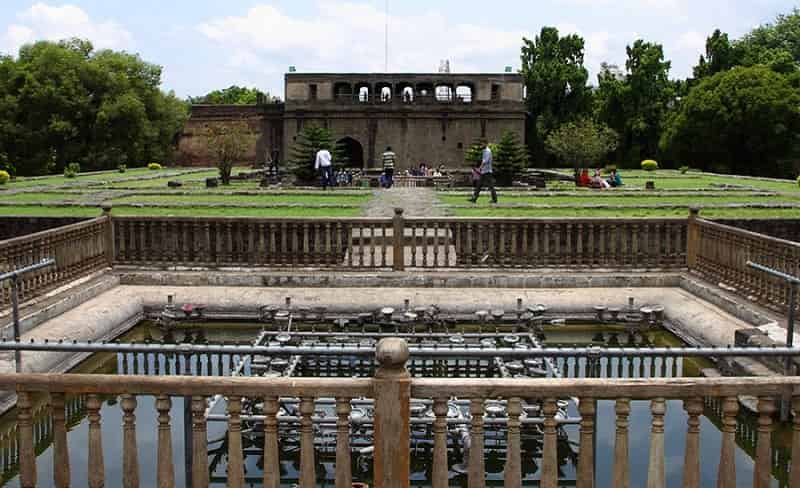
Shaniwar Wada is one of the most famous attractions of Pune. It is palace that built in 1746. It was the pride of the Maratha Empire during that time. They seated the place until 1818 when it was surrendered to the British. In a tragic incident in 1828, a large part of the palace was destroyed due to an unexplained fire. A few parts of the palace left and that is now opened for travellers.
During the 18th century, the fort was a prominent centre of Indian politics. Marathas kings and solider gathered to the palace for meetings. The palace was made from the stone was brought from the lime-belts of Jejuri. The doors of the palace were made from a tough wooden called “Teak.” It took 2 years to complete the palace.
The timings for the Sound and Light Show in Marathi are 7:15pm to 8:10pm and the timings for the English show are 8:15pm to 9:10pm.
Today, the saved part of the palace is for public display. The fort has 5 gates. The Dilli Darwaza is the main gate that has a huge door. There are 3 halls, beautiful ceiling and wall paintings can be seen and the ceilings of the halls were hung with beautiful chandeliers. The marble finishing of the floors will leave you mesmerized.
Korigad Fort
- Location: Near Savashni Ghat, Lonavala, Aamby Valley 412108 Pune, Maharashtra
- Built by: Chatrapati Shivaji Maharaj
- Built in: 1657
- Entry Fee: No Entry Fee
- Timings: 9:00 AM – 6:00 PM
- Visit Duration: 3 to 4 hours
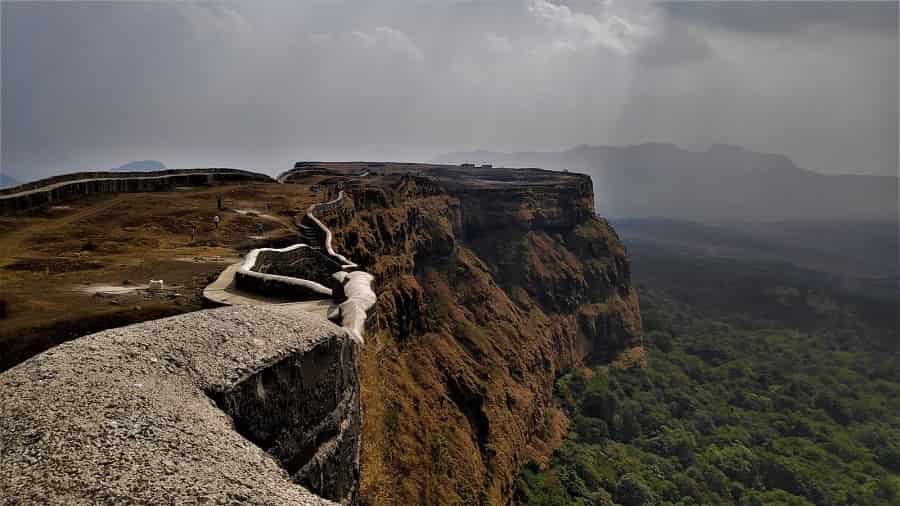
Ranking among the most visited sightseeing locations in and around Pune, Korigad Fort is known for its sheer architectural beauty and stands stoic in beautiful natural surroundings. The climb to the dominating premises of this fort is quite tough and is not advisable on an excessively hot morning. However, once you reach the top of the hill on which this fort is located, you will find that your efforts were worth the cause.
The spellbinding views of the environs and the two lakes located within the confines of Korigad Fort are certainly worth a look. Here, you will find small temples dedicated to Lord Shiva and Vishnu and you are bound to be captivated by the magic of the serenity all around you. Some parts of the fort have been recently renovated while quite a few of its portions still stands in ruins.
This fort was included in the list of forts occupied and maintained by Maharajah Shivaji, along with the forts of Lohagad and Tikona. The location is a must visit for its stunning views and the architectural bounties of its historic fort.
Sitabuldi Fort
- Location: Address: Madha Colony, Sitabuldi, Nagpur, Maharashtra 440001
- Built by: Raja Bhakta Buland Shah
- Built in: 1702
- Timings: 24 hours
- Time Required: 2-3 hours
- Entry Fee: Free
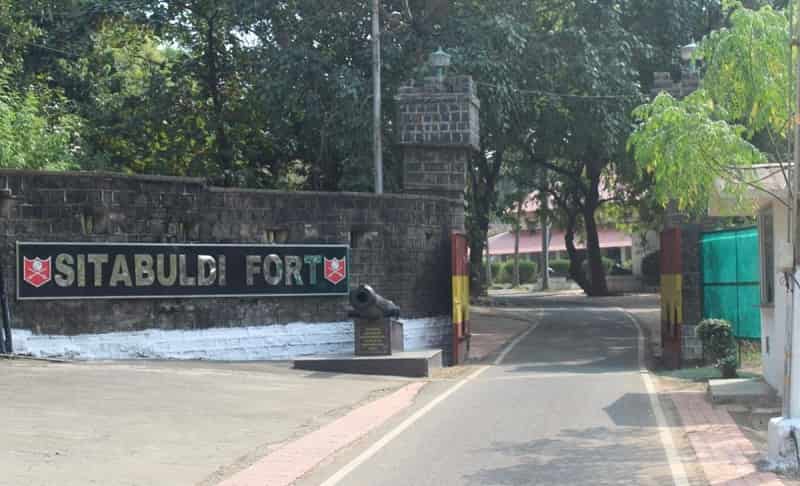
The Sitabuldi fort is located on hill which is situated right in the middle of the town of Nagpur, in central India, Maharashtra. This fort was the site where the battle of Battle of Sitabuldi was fought in the year 1817. The fort was originally built by Appa Sahib or Mudhoji II Bhonsle of the Kingdom of Nagpur, right before the battle with the British East India Company was fought, during the period of the third Anglo-Maratha War.
The fort is now the home of the Indian Army’s 118th infantry battalion. In the present times, the fort has been solely occupied by the Indian Army and cannot be accessed.
The region surrounding the hill is referred to as Sitabuldi and is considered to be an integral commercial base for the city of Nagpur. Towards the south of the hillock is the railway station of Nagpur and towards the backside of the hill is a temple to which is dedicated to Ganesha, known as Tekdi Ganapati. This temple is considered to have been constructed by Bhonsle kings of Nagpur Kingdom.
Rajgad Fort
- Location: Rajgad Fort, Rajgad, Balekilla Rd 412213 Pune, Maharashtra
- Built by: Chhatrapati Shivaji Maharaj
- Built in: 17th century
- Entry Fee: Free
- Timings: 10:00 AM – 6:00 PM
- Visit Duration: 1-2 hour
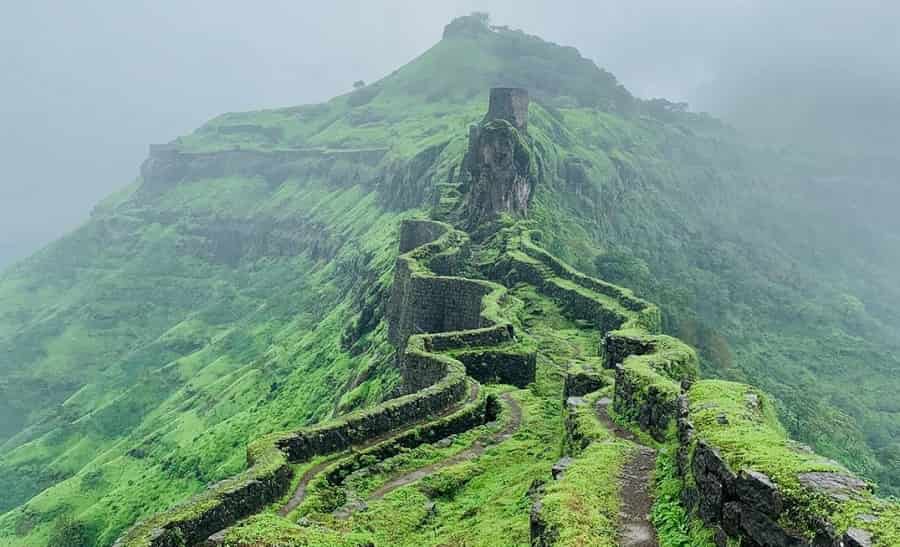
If adventure and history excite you and are your idea of a great vacation, then head onwards the dominating heights of the Rajgad Fort, Pune. This majestic location lies in the lap of Sahyadris and is a popular place of sightseeing –for its natural beauty and historical significance alike. According to folklores and legends, Shivaji Maharaj—the famous Maratha ruler, had chosen Raigad as his home for more than 25 years and had later moved his capital to this colossal Fort.
Along with its famed architecture as well as significant historical contribution, Rajgad Fort attracts tourists with immense opportunities of trekking and horse riding in the lush forests beyond. So, do not be surprised to see enthusiastic people walking along well beaten tracks or making their way up to the Fort. If you are planning to do the same, then it is well advised to carry y along a suntan lotion, a sturdy pair of shoes and a bottle of water—all the best for a happy trek!
Bassein Fort
- Location: Police Colony, Vasai West 401201 Vasai, Maharashtra
- Built by: Yadavas of Devagiri
- Built in: 1184
- Timing: 9 am – 6 pm
- Time required: 2-3 hours
- Entry fee: Free
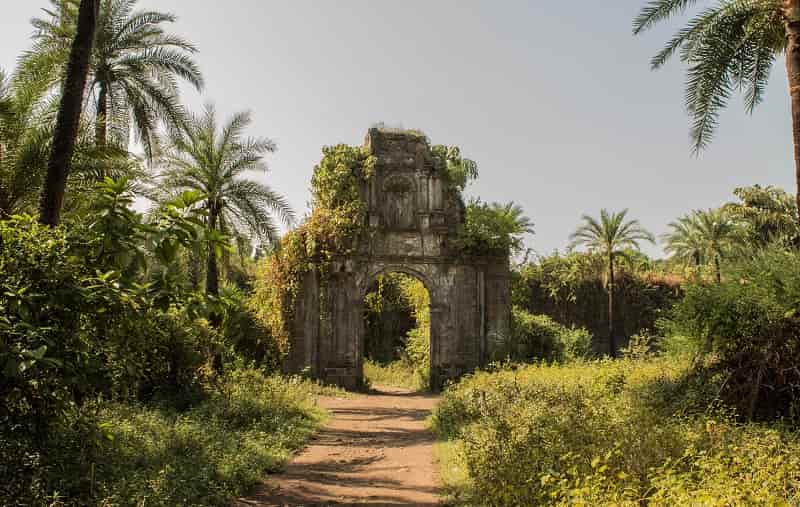
The Vasai or the Bassein Fort is a huge fort located in the village of Vasai. This is located in the Vasai taluka of the District of Thane, Konkan Division in Maharashtra. Accessing both the fort and the village is very convenient as they are easily reachable from the Vasai Road Railway Station. This railway station is situated in Manikpur-Navghar, a part of the recently established City of Vasai-Virar, which is located in close proximity to the northern side of Mumbai and the cities of Mira Road-Bhayander. Additionally, this railway station is the third last stop along the Western Railway line.
Currently, the parapet offers views of the Vasai Creek and the Bhayander Creek, but these water bodies have been mostly obscured by overgrowth of vegetation. One can still see many watch-towers and all of these have safe staircases. The Portuguese buildings inside the fort are in terrible state and dilapidated state. One can still figure out the floor plan of these buildings. Very few of these builds are still preserved. One can see that over the years a few of these builds have actually been maintained nicely. These builds are mostly ornamented with carved stones. Some of these cannot be recognized while there a few which display some peculiar moulds and marks.
Arnala Fort
- Location: Arnala, Maharashtra 401302
- Built by: Sultan Mahmud Begda
- Built in: 1516 AD
- Timings: 6 am – 6 pm
- Time required: 1-3 hours
- Entry fee: Free
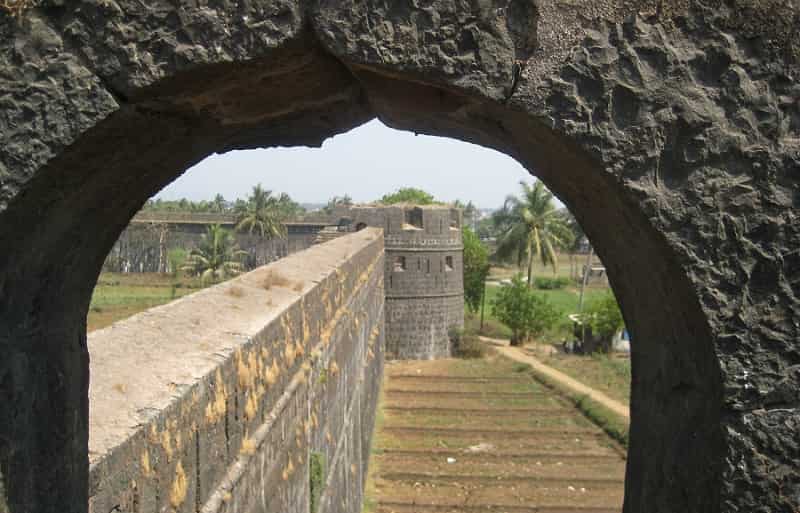
The Arnala Fort is located on an Island and is at a distance of 8 miles north of Vasai, In Maharashtra. Since this is an Island fort, this is also known as Jaldurg or Janjire-Arnala. The Island fort was initially built by the Portuguese, who also owned this fort and later rebuilt and named it Ilha das vacas.
Octagonal Water Reservoir and Temples: Inside the Island fort there is huge octagonal fresh water reservoir , along with temples which are dedicated to various gods and goddesses, like Lord Shiva, Ambakeshwar, Goddess Bhavani, , and one can also see the tombs of Hajjali and Shahali. The sacred sandals or ‘paduka’ belonging to Shri Nityanand Maharaj have also been preserved here in a dome on the eastern face of the fort.
The main entrance of the fort is in the Northern direction. There is a solid stone doorway which is beautified with pictures of tigers and elephants. In the Southern end of the island there is a Southern Watch Tower, this is located at a distance of 550 meters from the main fort. There are no entrance gates for this tower.
Torna Fort
- Location: 70 km southwest of Pune
- Elevation: 1,403 m
- Built by: The Shiva Panth
- Built in: 13th century
- Timing: 24 hours
- Time required: 3 – 4 hrs
- Entry fee: No entry fee
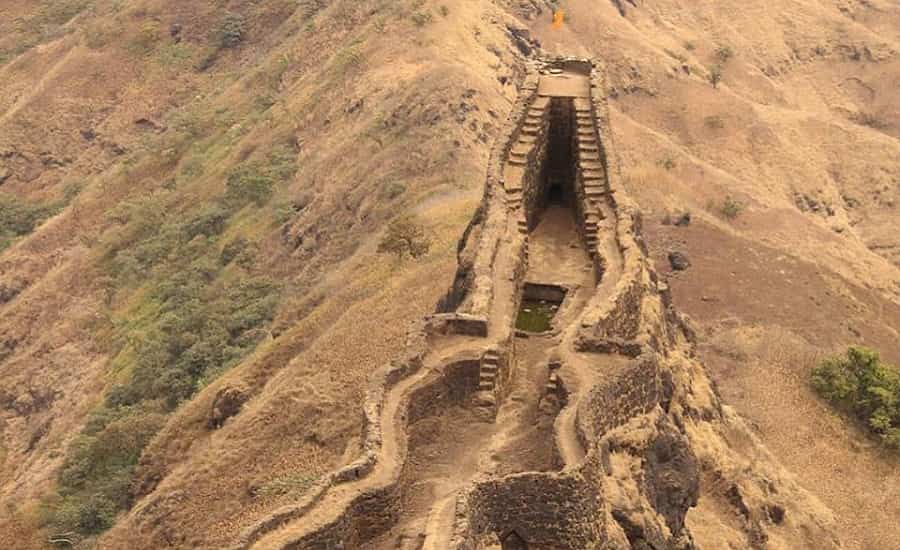
Yet another fort from Maharashtra which accounts a very significant history of Maratha Empire. The name of Torna Fort is still written in golden letters in Maratha history as it the seal mark of the bravery of 16-year-old Shivaji Maharaja. The journey of unflinching and intrepid warrior Shivaji started from here. He conquered this fort from mighty Mughals at the age of 16 and told the world about his intentions. After conquering, Shivaji further added many fortifications to the fort though he hadn’t spent much time here. Torna Fort is easily accessible from Pune because it is 65 km from the city. It is one of the tallest and massive forts of Maharashtra and serves as an absolute delight for the trek lovers.
These are the forts to visit in Maharashtra. Each of them has embraced a glorious history within its four walls. So, visit them and suss out the prideful India history. You’ll definitely get astonished by the architectural as well historical splendor of these forts
Apart from forts to visit in Maharashtra I have written one more blog post Places to visit in Maharashtra which will give you overview of all famous tourist destinations in Maharashtra.
